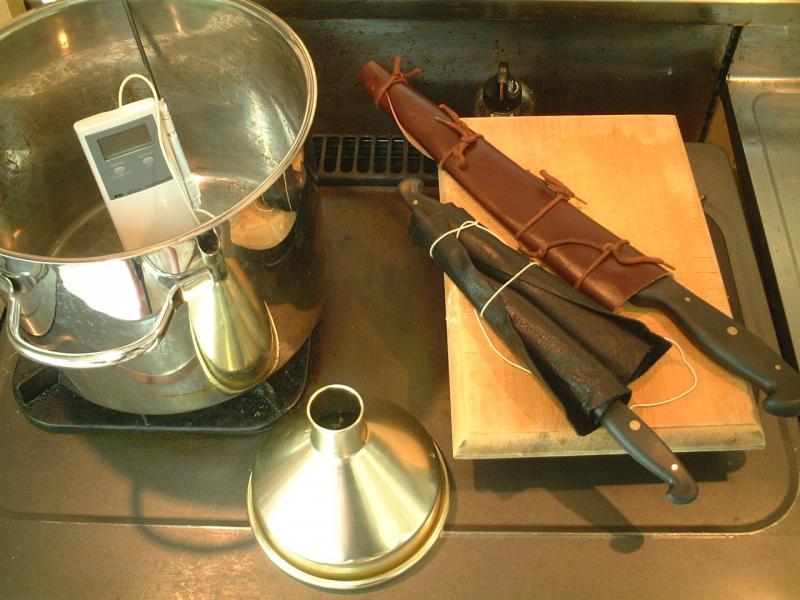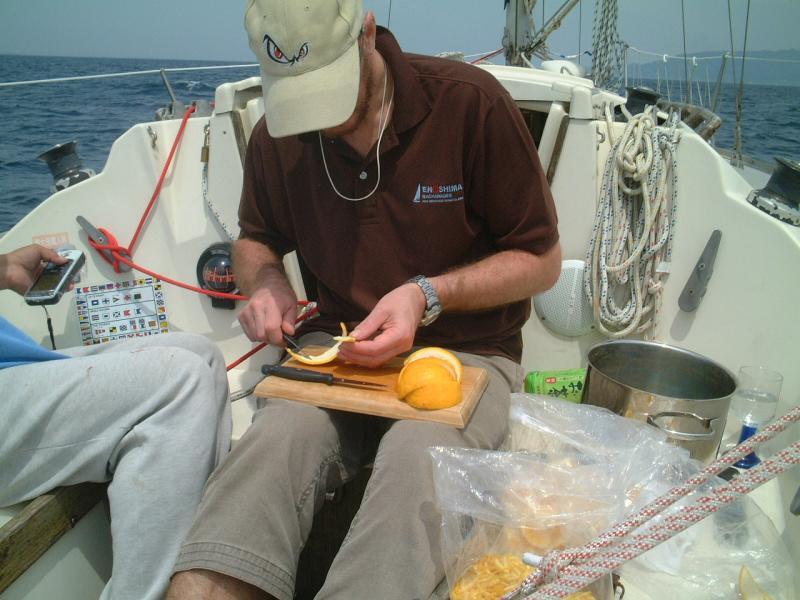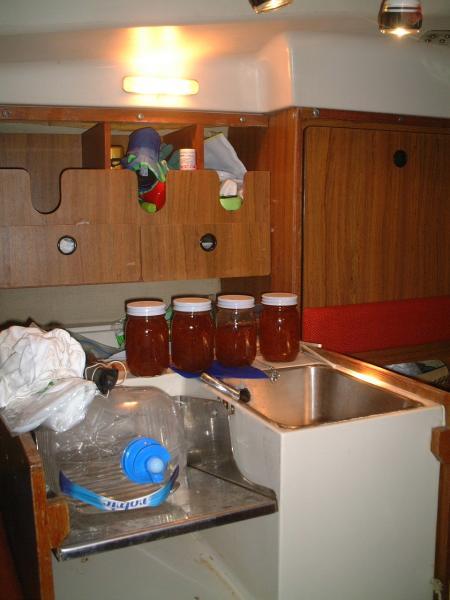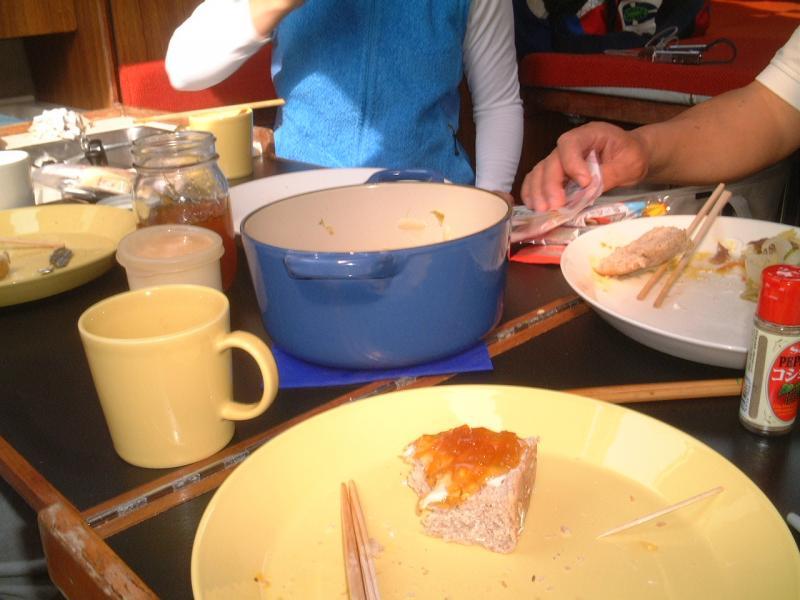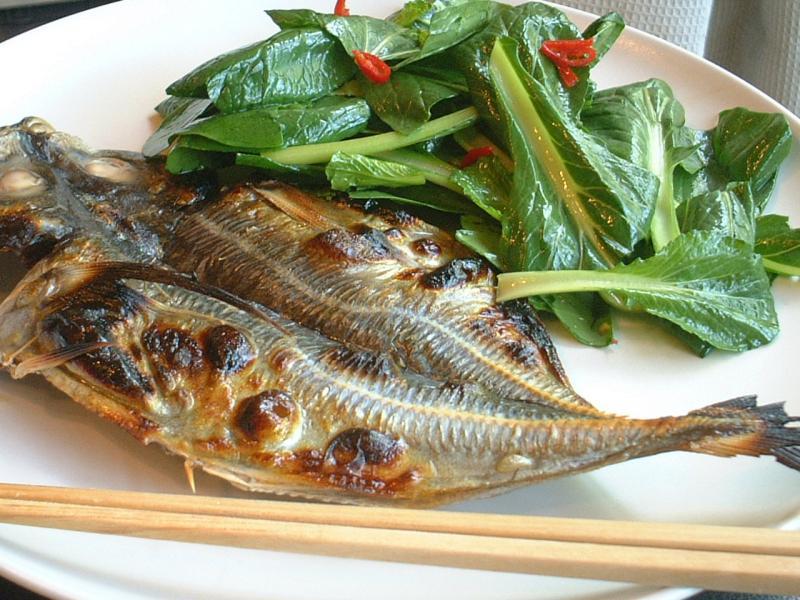-
Posts
1,728 -
Joined
-
Last visited
Content Type
Profiles
Forums
Store
Help Articles
Everything posted by Blether
-
Thanks, Dougal. Yes, as I think I mentioned, I did taste it cloudy, as is, during fermentation. I'd prefer to get it clear, though it's not the end of the world if I don't; and I'm not desperately bothered about it being ready quickly, for its own sake - only to make sure it doesn't hang around so long as to spoil. I appreciate your tips on yeast; what's available to me in this country remains for me to investigate. Having fortified it (I only followed the recipe; I guess you're right about that being to kill off the yeast), I'd hoped not to have to worry as much about perfect sanitation as home brewers do. Am I wrong ? My syphon plan involves a flexible food-grade rubber hose... what's a Buchner ?! How would I use egg whites ?
-
Yes, Heidi, with tops still attached, and fresh, plump, unblemished white outer skins. I'm sure they were picked the morning that I found them in the market. Flavourwise they're fine - they've a good, oniony bite, enough so that I'd hesitate to use them fresh in a salad in any volume. And post-chutney-making my pad smells nicely sulphurous. Sadly the chutney recipe's turned out sweeter than I'd prefer. Maybe I'll make stuff a bit sour to go with it.
-
Lots of recipe ideas here, and one I like the look of here at recipezaar, too. What about keeping onion confit ? I'm a beginner at the game but I scored a bunch of beautiful fresh new-season onions out in the countryside, and I've put confit on the list beside the caramelised onion chutney I have bubbling on the stove right now. I'll have onion confit made from 4lbs of onions. How can I keep it ?
-
Yes, wow ! Nice one, Stuart. This is kind of a story of Tuesday's breakfast, and kind of a story of making a breakfast staple, and kind of a story of kitchen improvisation. I really couldn't think where to post it, but finally, breakfast it is. We had a plan for the Golden Week holiday, leaving early Saturday morning, and I've had this season's natsumikan marmalade on my mind. I got access to a tree with a much later crop than the one I usually use (mid-March harvest) but had missed this year because of the timing. On Friday I was full of beans and resolved to have a go at taking the necessary stuff with me and making the marmalade on the run, despite having to carry all my luggage by train and on foot. I took this partial photo of marmalade-kit packing after the event: natsumikan, empty jars and single-burner gas stove and canister not shown. I wrapped up my knives in a couple of pieces of leather I've had lying around for years, since the time I was experimenting with leatherworking. I think the old brown shoelaces add a touch of class (short knives shown pulled out for clarity): We left Tokyo by train to sail my friend's boat from the Pacific coast of Chiba round to the Shonan coast in Sagami Bay. Cruising's fun, of course, but leaves ample opportunity for free time, depending on the weather conditions. With a stock of plastic bags, I was able to break down the fruit into peel, shredded peel & (everything else), little by little as time allowed. My usual approach in the kitchen is to juice the fruit, then separate into peel and (everything else). On the move, it seemed to make sense just to separate the peel, keep segments and pith together and juice by hand later just by squeezing the segments in my fist. In the end you're suspending the pith, seeds & pulp in a net in the (juice and water) in the pot, before finally removing the net and squeezing out the liquid from that - so the juice will work either way. I started cutting, paring and shredding at our first port of call, near Tateyama: Made progress on the second day on the water: ... and finished preparing the fruit on deck in the marina at the second port of call. Eyeballing the volume of water, I boiled the peel and bags of fruit discard till the peel was soft (actually I think having kept the peel and shredded peel in plastic bags as I prepped it meant the peel was more easily and more quickly softened, though I think having very ripe fruit helped, too (shook the tree rather than picking individual fruit)). I'd worked out my sugar proportions on paper and given away enough pieces of natsumikan to bring the total weight to a good match for the 1kg of sugar I picked up before we sailed (no weight or volume measures on board; I weighed the fruit before leaving home). I boiled to 105C and poured straight from the pot into the washed jars, using the funnel I'd brought (in fact bought, a few years back) for the purpose. Yes, we can: Finally, breakfast on Tuesday, our third day on board: The skipper was making an expert job of showing how to cater for four people on a 25' boat, using only a single burner (the ship had its own; I'd brought mine unexpectedly). This breakfast was eggs poached two at a time, free-form, in a square tamagoyaki pan, and served over delicious brown bread (our first day's pilot owns a bakery company !) with processed cheeses slices and Japanese-style pre-cooked bacon; and vegetables steamed in their own juice and mixed with a tin of anchovies. This was also a demonstration of a piece of Le Creuset used in a proper application for its true properties - getting it hot over the gas ring, then leaving the veggies to steam and stay warm while the eggs were cooked. Of course the not-completely full jar of marmalade came out for the remaining bread, and the three full jars made a nice present for each hand.
-
Don't you use a freezer and small keeper boxes ? Microwaves defrost one-portion sizes; 2 or 3 portions will keep in the fridge after defrosting. And are you seriously eating pasta that often and not paying a tithe to Marcella Hazan ?! I'll pass her 'North Italian white sauce' on to you here - just butter and grated parmesan, added in alternate lots (about three batches) and tossed each time. Mmm.
-
Finally I found the two minutes it took to check on the wine. It's still pretty cloudy - I shone in a two-AA Maglite and could see about an inch and a half or two inches into the ginger lumps and other stuff floating on top and sunk to the bottom. So... again, finings ? Filtering ? Something else ? Can anyone help ?
-
In practice they're probably most often called niku man or piza man or similar, but that 'man' is originally, and formally, manju, isn't it ? Are you saying that's not so ?
-
Indeed but don't get me started. Seriously. Anyone for a trip to a branch of famous beer hall, Kirin Shitty ? See ? You've done it now.
-
I still haven't even looked, and I'm off for Golden Week tomorrow ! What a freakin' day !! Thanks for the ginger Shochu idea, Helen, that's a great one. In my sheltered life, I'd never come across a ginger shochu before; I'll definitely be giving it a try (prod me if I seem to have forgotten to tell you how it went). I will be glad when this natch is in the bag. Commuting to my offshore jurisdiction pied-a-terre and dictating posts back over the radio every day is really doing my head in.
-
That's up to your usual high standard, Bruce; but shouldn't you be calling it chicken hora-pa ? (Link - see under 'herbs & spices' - if you click through, they even have pronunciation audio).
-
Thanks Peter, that is a great presentation - thanks for posting it, and thanks to whoever produced and made it available. I almost feel guilty - could the guests there even follow the show as well as we Tubers ? I love the way they refer to the gills as chongmage as they lay them in the deep oil. "Samurai hairstyle".
-
How does it come about that these are known as (o-)manju in Japan, given the obvious word resemblance for shumai, gyouza (?) & others ?
-
Great stuff, everyone. Lovely picture of a good-looking breakfast there, Kim, ditto yours, kayb. I was split between turning left and picking up 2 sausage muffins from McDonald's, or going right and putting in some effort. I put in some effort, picking up another two salted aji and a pack of komatsuna. Komatsuna's somewhat like spinach, and has a nice mustardy flavour, so three heads got spinach-like treatment, as a rustic salad dressed with some heated up bacon fat from the pan sat on the stove for a couple of days, cut with a splash of konbu ponzu and a chopped home-produced chilli from the freezer. I reckon that's a pretty good bacon surf'n'turf; backstop of coffee and breadmaker 100% wholewheat not pictured. Delicious ! I spent less at point of purchase than I would have for the single meal from McD, and I've got two of these breakfasts and plenty of leaves left over. Bye, Ronald. In the fine print, the aji pack says, processed in Numazu (Shizuoka prefecture) using super-duper water from Mt Fuji and specially selected salt; using fish produced in... Holland. Four bucks for two. As a treat, I resisted the clearance stock on the same shelf at half price.
-
Nor does it sound like summer food, or something kind to offer during a California summer, either I've been wading my way, slowly, through Patrick Leigh Fermor's Between the Woods and the Water, and just a chapter or so ago he was waxing lyrical about the Hungarian summer produce - peaches, apricots, endless fruit, but above all 'paprika' both mild and hot, in vast quantities; and energetic dancing with chants of hai! hai! hai! hai! spurred by 'the new apricot brandy'. (He's not a gourmand, Paddy, so no detailed menu reports - landscape and townscape you can have by the shovelful. And I just found another use for Google books, for still-copyright works - you find an edition with limited searchability, look for 'apricot' and there's your page number, or close to it). Oh, and here we are - "The summer solstice was past... Roast corn-cobs came and trout from the mountains; cherries, then strawberries, apricots and peaches, and, finally, wonderful melons and raspberries. The scarlet blaze of paprika - there were two kinds on the table, one of them fierce as gunpowder - was cooled by cucumber cut thin as muslin and by soda splashed into glasses of wine already afloat with ice; this had been fetched from an igloo-like undercroft among the trees where prudent hands had stacked it six months before, when - it was impossible to imagine it! - snow covered all". At this point he moves into a description of the abundance of apricots, dotting the road dust, trampled underfoot and squashed by cartwheel, the heady scent of their fermentation in tall wooden vats filling the yards, and the new spirit bowling over the peasants "like a sniper, flinging the harvesters prostrate and prone in every fragment of shadow. Thay snored among sheaves and haycocks and a mantle of flies covered them while the flocks crammed together under every spread of branches, and not a leaf moved". Undercroft. That's it, my fridge has been re-christened.
-
Sorry - also, if it doesn't get clear, should I be thinking about finings for this recipe (/ is there some other approach) ? How long should settling take / how long should I leave it before intervening ?
-
A late update (late compared to the events): The wine was still gassing reasonably well at the prescribed time limit. What with the old recipe, the bodge I made of the proportions for a large part of the indicated fermentation time, and my own inexperience and unfamiliarity with what would be the accepted readings between the lines in Meg Dodds' day, I decided to taste it during each daily stir and go by sweetness. Finally, though there was still gassing, I decided it tasted right and added the fortification (my standard smooth, mellow whisky, Teachers Highland Cream, in place of brandy) after exactly 4 weeks, not 2. Ambient temp was a pretty constant 20C or so throughout. It remains sitting in the dark cupboard where I put it then. It must be close to 4 weeks there, too, now - I've barely even looked at it (I've simply been busy). Can anyone (Nayan ?! ) comment on what the likely keeping properties will be ? I'm planning to simply decant into screw-top wine and whisky empties. Am I stupid ? No, wait a minute, I'll rephrase that: is that stupid ?
-
... or you can serve your stew / braise with bread. Naan being hard (and relatively labour-intensive) to replicate at home without the right kind of oven, I like buttered wholewheat toast with a lazy curry - typically a microwave-reheated one. I mostly cook rice by bringing it to the boil and simmering in the oven for 25 mins at 170C. You might find you can time it to cook in the oven from cold, somewhere north of an hour. Otherwise, Lancashire hotpot Some good, thick sausages roasted on a rack so the juice can drip on previously par-boiled potatoes / roots, or into a dish of red cabbage, apple & juniper Shepherd's pie, with a good layer of veggies Cottage pie, likewise Fish pie in the same vein, i.e. with mashed potato topping - use a mornay sauce and white fish; add peas or mushrooms according to fancy; or use a white sauce without the cheese, maybe mixing in sliced fennel Pie (pastry pie) of any kind with a balanced filling, like chicken & leek, or beef with carrots / root veggies Pasties as seen in A Pocketful of Dough
-
MeniInProgress, that's a very authentic-looking bowl of noodles. David Ross, your risotto also looks fantastic, even though I'm not an asparagus fan. Likewise, MiFi, just about everything there, but especially the torte and the pea additions to the carbonara. Great idea.
-
You scoop the flesh from the skins; but you want to char everything enough that some of that flavour has penetrated the flesh. I made BG a few times last year when I had the charcoal grill lit, using the same goma (sesame) paste that Japanese & Chinese grocers carry for things like making shabu-shabu dipping sauce. I used the recipe from Christine Osborne's Middle Eastern Cooking, but also copied one from Gordon Ramsay off the web. It was much the same.
-
I'm a dedicated follower of fashion. Interesting approach, that I've not heard before. I go by salt weight to volume of water. Another rule of thumb I've read but not tried is that an 80% brine is just strong enough to float a fresh raw spud.
-
What David said about eggs. I use an ordinary bread flour and get a good yellow colour.
-
I didn't remember the origin details till I referred back to my recipe just now, where I've noted "Erlandson sweet pickle with spicing based on Harvey/Kinsella and brining technique on Dubbs / Heberle". In summary, I use an 80% brine and wet cure for 3.5 days. My taste is about middle-of-the-road. As a Brit, I like 'green' or cold-smoked / raw unsmoked bacon. All the domestic-produced bacon I've ever found in this country is either hot-smoked, or if not smoked at all, then pre-cooked somehow. It never crisps up the way I like, but I've not bothered to nail down whether that's because of the pre-cooking, or because of something else. It goes dry and hard, but not crisp. (I can get imported green bacon that cooks the way I like it).
-
Well if you're going to get boastful, I'll bet I can give you a run for your money on incompetence and ignorance, any day of the week I wasn't clear, but my intention was to point out the difference in drying rate because of different humidity inside & outside the fridge (guessing fridges are fairly consistent, but ambient varies), rather than to suggest that the outside humidity determines that in the fridge. Thanks for your more knowledgeable explanation, from which I've been able to learn something.
-
Beautiful again. It looks like you got good structure in that pastry.
-
Thanks for posting such a well-written explanation, oldwhiteguy: Just what's needed, no hurry or fuss, and enough background to be able to adapt the procedure to different conditions. Great ! The only thing that read as strange to me was: Where I am, the fridge is normally drier than the surrounding air. I use that sometimes - for drying out the surface of poultry before cooking, for example. Where are you located ? Anyway I'm guessing that what you wrote is how you did it, right ? Any more comments about 'nutty' and 'slightly sharp' and I'll be digging a cold cellar into the apartment below.



